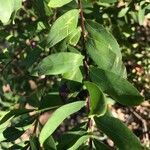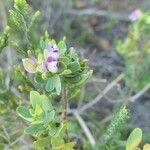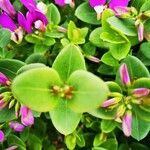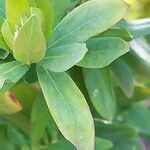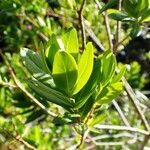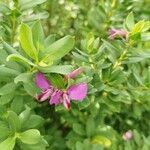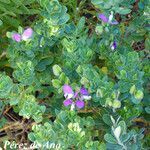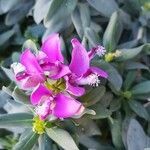Perennial much-branched shrub up to 2 m high. Young stems with short curly hairs, glabrous when older. Lvs all alternate, glabrous or very sparsely hairy, elliptic to obovate, obtuse or rarely slightly retuse, entire, (10)-15-30-(35) mm long; petioles 1-2 mm long. Fls clustered in short, simple, terminal racemes; perianth coloured or veined purple toward apex; pedicels 5-8 mm long; bracts suborbicular, 2-3 mm long, persistent; 3 outer sepals ovate, 5-7 mm long; wings petaloid, ovate-orbicular, c. 15-17 mm long, slightly > corolla; outer petals 2-lobed, c. ?-1/4 length of keel; keel with a fimbriate crest near apex. Capsule glabrous, c. 10 mm long with a marginal wing c. 1 mm wide, c. ⅔ length of persistent calyx wings; seeds hairy, dark brown, oblong, c. 5 mm long; strophiole 3-lobed.
Branched shrub, erect, densely leafy, glabrous or pubescent, 0.3-2.0 m high. Leaves alternate, shortly petioled, erect, sometimes glabrous; blade spreading-ascending, variable in size and shape, oblong, elliptic, linear or acicular, usually not reducing in size towards apex of twigs, margins in broad leaves slightly recurved, in narrow leaves strongly revolute, apex acute, obtuse, broadly rounded or subtruncate. Flowers large, papilionaceous, in short terminal racemes, magenta and green, varying somewhat in size, often 20 mm long. Flowering time all year. Fruit a laterally compressed, membranous capsule. Seed oblong-cylindric, pubescent, caruncle large, white with 2 dorsal claws reaching beyond middle of seed and one ventral claw < 1/2 as long as seed.
Shrub, up to 1.3 m high; not spinescent. Stems virgately branched, sparsely to densely appressed; crisped pubescent. Leaves petiolate; blade oblong-elliptic, ± 25 x 5 mm, apex obtuse; petioles 1-2 mm long. Flowers: in lateral racemes; wings suborbicular, ± 10 x 9 mm, apex rounded, base asymmetric; wings and petals purplish pink; Sep.-Nov. A very variable species. Description alludes to specimens occurring in a mountainous area.
A sprawling shrub. It grows 2 m tall. The young parts can be velvety. The leaves point upwards and are narrow with edges the curl back. The flowers are large and in short groups at the ends of the branches. They are purple and the side petals have 2 lobes. The lower lobe is longer.
Sprawling or erect shrub, up to 2 m tall, often velvety on young parts. Leaves ascending, linear with margins slightly revolute to elliptic-obovate and flat. Flowers large, in short terminal racemes, purple, side petals bilobed, lower lobe much longer than dorsal.
Sprawling or erect shrub to 2 m, often velvety on young parts. Leaves ascending, linear with margins slightly revolute to elliptic-obovate and flat. Flowers large, in short, terminal racemes, purple, side petals bilobed, lower lobe much longer than dorsal.
